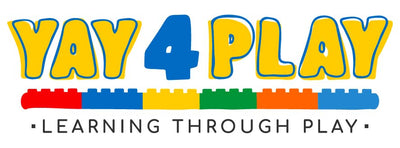The Six Bricks methodology is a way of including developmentally-enhanced activities into your class. The method is based on substantial research into how just six Duplo-style bricks provide a solid base for learning a full range of skills – all in a hands-on way!
What is so great about the method is that educators can easily learn the method and then apply it in a whole range of flexible ways. The Six Bricks method has a demonstrable impact of teaching and on the way in which children learn!
Although the Six Bricks activities do not in themselves form a curriculum, they are a simple way of extending a formal curriculum in a creative way.

Here are your 5 simple steps to introduce the Six Bricks method into your class:
1.You need resources – either determine if you have the right colour bricks already in your centre or purchase them from Yay4Play. The colours are: red, orange, yellow, dark blue, light blue and green. If you don’t have sufficient colours, children can share what you do have available.
2.Use some of the easy activities that don’t require preparation and where the instructions are straightforward to follow. This will assist you in building confidence so that you even start to invenst your own activities. Examples are the tower activities that are used to develop fine motor movement, focus and concentration as well as perseverance and the ability to follow instructions. Towers can be constructed in so many different ways – tallest towers, towers that lean and don’t fall over, towers that tell a story, towers that balance an object on top of them – and so many more options!
- Number recognition
- Drawing
- Counting
- Checking and matching numbers
- They are also practicing copying and writing numbers.
4. Many classrooms have playful and educational learning materials. Six Bricks is a further addition and because of its versatility and the way in which it can be combined with existing resources, it’s an innovative way to increase learning opportunities.
For example: you can include the Six Bricks method with other objects that you have in your room to encourage children to learn more about positional language. The blue brick could be in front of the wooden block or the puzzle piece could be behind the yellow brick.
There are so many other ways of building language functions in groups so that children manipulate these objects on their own.
5. Finally, we recommend formal training in the methodology. It’s important to understand the background and the substantial amount of research that sits behind the Six Bricks method. Formal training also encourages you to explore the multitude of ways in which the method can be applied to encourage children to learn in a playful and meaningful way.
